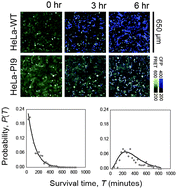Quantitative analysis of resistance to natural killer attacks reveals stepwise killing kinetics
Abstract
Molecular mechanisms can protect cancer cells from immune attacks. At the level of bulk tissue, these survival mechanisms are often indistinguishable and simply appear as reduced cell death. However, by tracking individual cell survival and death times, we found broad variation in the kinetics of immune evasion. In response to attacks by natural killer cells, we observed that some cancer lines exhibited exponential survival time distributions. Slowly killed cancer lines had reduced exponential rate constants. In contrast, a line engineered to express the serpin protein PI-9, which is known to promote resistance to immune killing, exhibited a markedly nonexponential survival time distribution. By following the histories of individual cancer cells with multiplexed reporters, we obtained evidence that two or more immune attacks are likely required to kill serpin-expressing cells. Thus, resistance is a finite and measurable quantity, with a distinct kinetic signature. A quantitative model based on independently measured parameters is consistent with our conclusions.


 Please wait while we load your content...
Please wait while we load your content...